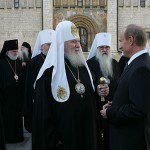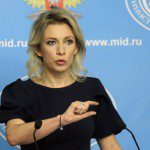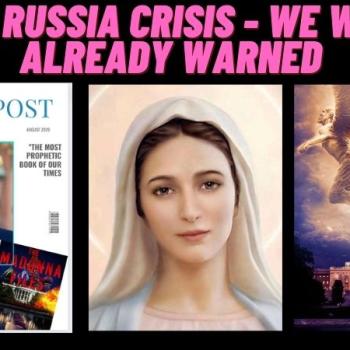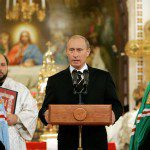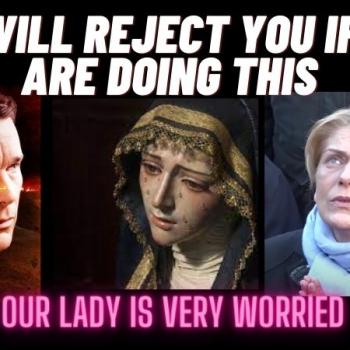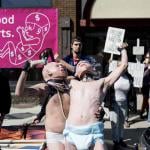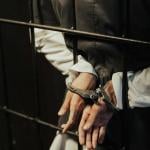Follow Mystic Post on Facebook
The Vatican was not aloof to these events or the bishop’s various public statements. While always prudent and cautious with regard to dealing with a bishop’s actions, Rome nevertheless acted forcefully in this matter. In 1986 the bishop submitted a negative judgement to Cardinal Ratzinger, Prefect of the Sacred Congregation for the Doctrine of the Faith at the Vatican and the future Pope Benedict XVI. Cardinal Ratzinger rejected the conclusions and then removed Bishop Zanic from his position as overseer of the investigation, dissolving the bishop’s commission. The Yugoslavian Episcopal Conference was then given responsibility for overseeing the matter.
Cardinal Ratzinger’s actions were quite extraordinary. Never in the history of reported Marian apparitions has the Church hierarchy intervened in such an authoritative way by overruling a local bishop’s statement and removing him from the responsibility of overseeing the case.
Bishop Zanic was eventually replaced by Bishop Peric, a monsignor who was recommended by Zanic because of his opposition to Medjugorje. Bishop Peric wrote a personal letter declaring his position to be that nothing supernatural was occurring in Medjugorje (the third designation). But in order not to lead the faithful into believing that his statement was an official Church position, Archbishop Tarcisio Bertone, the Secretary to the Congregation for the Doctrine of the Faith that was presided over by Cardinal Ratzinger, wrote in a letter to the bishop of Saint-Denis de la Reunion that “What Bishop Peric said in his letter … is and remains his personal opinion.” Thus, no one was to regard Bishop Peric’s statement as any kind of official Church declaration. It was to be viewed as opinion only.
T h e S t a t u s o f M e d j u g o r j e
Part 1
Many Catholics have asked what status Medjugorje contains within the Church — whether it has been officially approved or condemned. Like all apparitions, the Church will not give full approval until the reported apparitions have ceased. In the meantime, people are often curious to know what formula the Church uses in its investigation to determine whether an apparition is genuine.
The Church seeks three pieces of information in evaluating an apparition:
- Do the messages conflict with Scripture or Tradition?
- Is anything supernatural occurring at the site or as a result of the apparitions?
- Are good fruits of conversion and repentance coming from the place?
With regard to the first question, many notable theologians and Church officials traveled to Medjugorje to judge the authenticity of the messages. One of the most respected theologians was Fr. Rene Laurentin. Laurentin is widely recognized as one of the 20th century’s greatest theologians and is the author of more than 150 books and 1,000 scholarly articles on theology, biblical exegesis and Marian apparitions. His book Is the Virgin Mary Appearing at Medjugorje? became a foundation for those choosing to understand the events more clearly. He states in his book after a thorough theological investigation of the activities and messages that “there are no doctrinal problems at Medjugorje.” [1]
Another theologian, Fr. Michael O’Carroll, studied the events and concluded that the messages were completely orthodox. His book Medjugorje: Facts, Documents, Theology, included the statement that “after having studied the facts of Medjugorje in books and [in Medjugorje], I am entirely convinced of the authenticity of these apparitions.” [2] He also cites Fr. Laurentin’s works and states that the famous theologian concluded “There is notable doctrinal orthodoxy….” [3] Finally, in an interview with the Jesuit Fr. Richard Foley, Hans Urs von Balthasar, the first recipient of the Paul VI prize for theology and a giant of the 20th century in Mariology, stated for the record: “Medjugorje’s theology rings true. I am convinced of its truth.” [4]
Despite these pronouncements by famous theologians, the local ordinary, Bishop Zanic, who was originally in favor of the apparitions, later turned negative. He grew so hostile that the archbishop of the neighboring diocese, along with other high dignitaries, urged him restraint in the strongest possible language between bishops. Hans Urs von Balthasar wrote to the bishop: “My Lord, what a sorry document you have sent throughout the world! I have been deeply pained to see the episcopal office degraded in this manner.” He went on to say that Zanic was “bring[ing] out accusations which have been refuted a hundred times over.” [5] The Vatican also stepped in. A communiqué from the office of the Vatican Secretary of State of April, 1985, told Bishop Zanic in no uncertain terms to “suspend the diffusion of [your] personal declarations.” [6] It was no coincidence that the Vatican called the bishop’s communiques merely “personal” in nature.
 It seemed as if Bishop Zanic, though bound by obedience, did not hear. His animosity, some felt, began to move from uncharitable to disturbing. In one incredible interview, Bishop Zanic suggested the entire phenomenon was about greedy priests trying to collect money. He even went so far as to say that the reason he felt he must oppose the apparitions was because everyone else had been bribed. “It’s all a question of money,” he declared to Sacerdos, the diocesan newspaper of Leon, Mexico. “They [the Franciscans] are collecting enormous sums of money and they buy journalists, they buy theologians, they buy propaganda, they buy everything.” [7]
It seemed as if Bishop Zanic, though bound by obedience, did not hear. His animosity, some felt, began to move from uncharitable to disturbing. In one incredible interview, Bishop Zanic suggested the entire phenomenon was about greedy priests trying to collect money. He even went so far as to say that the reason he felt he must oppose the apparitions was because everyone else had been bribed. “It’s all a question of money,” he declared to Sacerdos, the diocesan newspaper of Leon, Mexico. “They [the Franciscans] are collecting enormous sums of money and they buy journalists, they buy theologians, they buy propaganda, they buy everything.” [7]
The Vatican was not aloof to these events or the bishop’s various public statements. While always prudent and cautious with regard to dealing with a bishop’s actions, Rome nevertheless acted forcefully in this matter. In 1986 the bishop submitted a negative judgement to Cardinal Ratzinger, Prefect of the Sacred Congregation for the Doctrine of the Faith at the Vatican and the future Pope Benedict XVI. Cardinal Ratzinger rejected the conclusions and then removed Bishop Zanic from his position as overseer of the investigation, dissolving the bishop’s commission. The Yugoslavian Episcopal Conference was then given responsibility for overseeing the matter.
Cardinal Ratzinger’s actions were quite extraordinary. Never in the history of reported Marian apparitions has the Church hierarchy intervened in such an authoritative way by overruling a local bishop’s statement and removing him from the responsibility of overseeing the case.
Meanwhile, on Nov. 28, 1990, the Yugoslavian Episcopal Conference sent a private letter to Rome stating that Medjugorje should be studied further without either approval or condemnation. Many of the faithful came to believe that the Episcopal Conference letter meant that nothing supernatural was happening and therefore Medjugorje would be shut down. But in fact, the determination meant that the question would remain open and further study would be done. In the words of Cardinal Kuharic, president of the Bishop’s Conference, “We therefore leave this aspect for further investigation. The Church is in no hurry.” [8] Medjugorje, however, was to be accepted by the faithful “as a place of prayer, as a sanctuary.”
Archbishop Franc Perko of Belgrade stated in 1991 that “It is not true that [the declaration means] nothing supernatural is happening in Medjugorje.” [9] He then added that the commission “is open to further developments.” [10]
Bishop Zanic was eventually replaced by Bishop Peric, a monsignor who was recommended by Zanic because of his opposition to Medjugorje. Bishop Peric wrote a personal letter declaring his position to be that nothing supernatural was occurring in Medjugorje (the third designation). But in order not to lead the faithful into believing that his statement was an official Church position, Archbishop Tarcisio Bertone, the Secretary to the Congregation for the Doctrine of the Faith that was presided over by Cardinal Ratzinger, wrote in a letter to the bishop of Saint-Denis de la Reunion that “What Bishop Peric said in his letter … is and remains his personal opinion.” Thus, no one was to regard Bishop Peric’s statement as any kind of official Church declaration. It was to be viewed as opinion only.
 It should be noted that many people erroneously believe that approval of an apparition site is the sole discretion of the bishop of the diocese. In actuality, this is not the case. According to Cardinal Ratzinger (prior to his being elected Pope), Rome does not intervene with a bishop’s investigation of an apparition if the phenomenon is small or considered “local.” “If we have only a local phenomenon it’s not necessary that the Vatican intervene,” he said. [11] In situations of greater importance, however, the Vatican will either confirm or refute the bishop’s decision with its own declaration. [12]
It should be noted that many people erroneously believe that approval of an apparition site is the sole discretion of the bishop of the diocese. In actuality, this is not the case. According to Cardinal Ratzinger (prior to his being elected Pope), Rome does not intervene with a bishop’s investigation of an apparition if the phenomenon is small or considered “local.” “If we have only a local phenomenon it’s not necessary that the Vatican intervene,” he said. [11] In situations of greater importance, however, the Vatican will either confirm or refute the bishop’s decision with its own declaration. [12]
If one is curious to know the thinking behind Pope Benedict XVI while he was still Pope with regard to Medjugorje, it is evident that as Cardinal Ratzinger he was instrumental in saving Medjugorje from the animosity of the local bishop. But perhaps his favoritism toward Medjugorje can best be summarized by a statement given by him in Austria on August 28, 1991. “This place,” he said about Medjugorje, “which has become a place of prayer and faith, [must] remain and come to be even more in the most interior unity with the entire Church.”
To be continued…
Craig Turner is a former journalist and writer. He is leading a pilgrimage this summer during the first week of August to Lourdes and Medjugorje.
[1] Is the Virgin Mary Appearing at Medjugorje?, The Word Among Us Press, Rene Lauentin and Ljudevit Rupcic, p. 119.
[2] Medjugorje: Facts, Documents, Theology, Fr. Michael O’Carroll, Veritas Press, p. 78
[3] Ibid p. 52
[4] The Catholic Herald, Nov. 22, 1985, and cited among other places in Medjugorje: Facts, Documents, Theology, Fr. Michael O’Carroll, Veritas Press, p. 56
[5] Letter dated Dec. 12, 1984.
[6] Cited in Medjugorje: Facts, Documents, Theology, Fr. Michael O’Carroll, Veritas Press.
[7] Sacerdos, Sept. 29, 1986.
[8] Glas Koncila (the Croatian Catholic Newspaper) August, 1993.
[9] 30 Days, February, 1991
[10] Ibid.
[11] interview with Roy Varghese at the Vatican, 1991, published in God-Sent: A History of the Accredited Apparitions of Mary, p. 228.
[12] Ibid.
[13] The Visions of the Children, Janice Connell, p. 266.
[14] Personal interview with member present on the trip.
[15] Melanie and the Story of Our Lady of La Salette, Mary Alice Denis.
[16] Ibid.
[17] Melanie and the Story of Our Lady of La Salette, Mary Alice Dennis, p 100.
[18] Ibid.
[19]A Concise History of France, Roger Price, p 171.
[20]Encyclopaedia Britannica, vol. 7, p. 664.
[21] God-Sent: A History of the Accredited Apparitions of Mary, Roy Varghese, p 136.
[22] Fatima: The Great Sign, Francis Johnston, pp 33-34.
[23] Cited in Medjugorje: What Does the Church Say?, Queenship Publishing, Sr. Emmanuel and Denis Nolan, p. 19.
[24] Gebet, #4, 1990.
[25] Letter written in Mother Teresa’s own hand to Denis Nolan, president of Children of Medjugorje, dated April 8, 1992.
[26] Miracles Do Happen, St. Martin’s Press, Briege McKenna with Henry Libersat, p 158.
[27] Cited in Medjugorje: What Does the Church Say?, Queenship Publishing, Sister Emmanuel and Denis Nolan.
[28] Ibid.
[29] ibid.
[30] Interview with Msgr. Kurt Knotzinger, president of the ecclesiastical institute Marian Lourdes Committee, cited in Medjugorje: What Does the Church Say?, Queenship Publishing, Sister Emmanuel and Denis Nolan.
[31] Ibid.
[32] Ibid.

